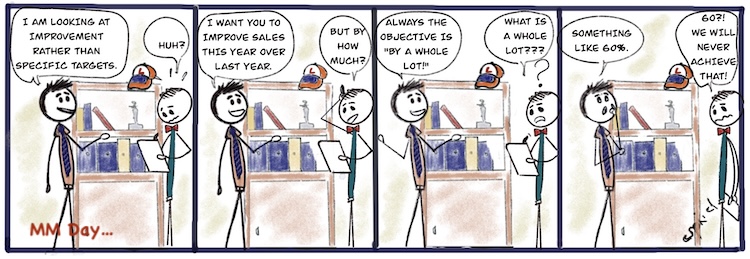Many managers struggle with approving KPI’s for their direct reports and, possibly ,for themselves.
The challenge originates from the tension that is created by the “push me pull me” nature of the negotiation. And KPI’s have become a point of negotiation. To help make the development of KPI’s an easy task I start with their purpose.
The intention of a KPI comes from the three words. KEY suggest that this is not an extensive list trying to cover every aspect of an individuals work. PERFORMANCE captures an element of judgement and how an individual is seen as fulfilling the expectation of their work success. INDICATOR is a measure of the performance that is key to their role. Putting these three words together it is clear that the KPI is a way of measuring the performance of an individual.
The tension is created by the way kPI’s are used.
Consider the following two ways of thinking about kPI’s:
1. A KPI is the measure I am able to use in a performance review to rate an individual employee. These reviews take place annually and therefore the KPI’s we’re not changeable once agreed.
2. A KPI is a measure of how an individual employee is performing and an indicator of where improvement is needed. KPI’s are used several times during a year to review how an individual is performing. KPI’s can be adjusted for valid reasons. The annual performance review is a ‘no surprise’ Conversation with the individual performer.
It is the way of thinking in paragraph 1 above that leads to undesirable behaviours.

The first behaviour is a negotiation by the employee to have a KPI measure that they feel comfortable achieving. The employee’s manager, on the other hand, considers using the KPI as a motivator to achieve targets that will ensure the achievement of their own kPI’s. These negotiations, generally, result in a watered down measure or, if the manager is insistent, a measure that the employee feels is unattainable and is therefore demotivating. Whether it is the employee or the manager who is unhappy with the result of the negotiation, one is likely to be unhappy. Consider the following scenario: A KPI for customers satisfaction reads ”Customer complaints will be less than 5%”. This can be reworded as “Only 5% of customers will complain”. It seems weird to have a performance that suggests that 5% complaints is OK, when the objective should be NO customer complaints. The same occurs with paying suppliers late, or errors made in encoding, or number applications to be processed.
The second behaviour is using SLA’s (Service Level Agreements) as KPI’s. For individual workers who are doing repetitive work SLA’s are very useful measures that will help a manager determine where coaching skills development might be needed. For this reason SLA’s are reviewed regularly to assist in these decisions. Using SLA’s as KPI’s puts them in danger of being ignored until the annual performance review.
The third behaviour is the rigidity with which the KPI is maintained even though other factors, affecting the KPI, might of changed. An example might be a sales number that was agreed at a time that certain marketing efforts we assumed. The assumption does not prove to be correct as marketing changed its plans, and yet, the KPI will remain has agreed. Or volumes might increase in applications received, or new products with problems launched, or a new strategy focus.
The fourth behaviour is the use of KPI’s as the foundation for performance reviews. The manager uses the KPI as a binary indicator of good performance or bad performance. This binary nature of the KPI’s leaves the manager in a situation of persuading the employee that they have under performed, even when the employee has being successful in a year which was very difficult because of changing circumstances.
What is the way out of this problem? Look at the way of thinking in 2 above:
2. A KPI is a measure of how an individual employee is performing and an indicator of where improvement is needed. KPI’s are used several times during a year to review how an individual is performing. KPI’s can be adjusted for valid reasons. The annual performance review is a ‘no surprise’ Conversation with the individual performer.
The first step is to link an objective to any KPI which is likely to be achieved less than 100%. For example customer complaints has an objective of zero complaints. The current level of complaints might be 5%. In looking at creating a KPI for such a person you were looking at improving the current situation. A KPI for this person might read:
Objective: Zero Customer Complaints.
Indicator: Reduce customer complaints from current 5%
Actions:
– Determine root cause of complaints by end of first quarter.
– Develop and implement solutions to root causes by end second quarter.
– Repeat in quarters three and four.
KPI’s in written in this way require the manager to ensure that the two actions are undertaken. While recognizing the current situation with complaints, the manager and employee are both aware that the objective is zero customer complaints and the most important actions to be taken or focussed on improving from the current reality.
This way of writing merges KPI’s with, what is known as, OKR’s (Objective Key Results). OKR’s have been written about and championed by Andy Grove. I have added indicators to satisfy the need to have a measure during the annual performance review. However, the manager will be ensuring the actions are taken and make decisions on the findings. The indicator is still being measured and by third quarter, if the solutions work the percentage complaints should be going down. Unless some new factor comes in to play.
So I call it “OKIR “Objective, Key Indicator and Results.”
You might realize, too, that the discussion about KPI’s changes to acceptance of current reality and looking to see what actions need to be taken to improve them. There is no arguing about a specific target number as the objective is clear and the indicator ‘improvement’ is also clear. If 5% goes to 4% then there has been an improvement. The manager recognizes that something needs to change if the number of complaints needs to reduce. My experience in process redesign tells me that often the root causes will be found in another department, function or policy. This will require the manager to be helping in bridging those gaps.
The frequent formal reviews every few months might cause a change in actions, which is fine as the objective and Indicator remain unchanged.
Reread the four behaviours that are unacceptable with KPI’s above. All four are addressed.
The dreaded Devil’s Advocate will say “The indicators need specific numbers not just a direction.”.
While this is a throwback to the need for negotiation a manager can add more specificity. In the example above the manager might want an indicator “Reduce Customer Complaints by 2%”. Even the use of a percentage can be scary as customers might double. Rather use the actual # complaints, as each complaint has a customer attached! Complaints may be increased because of product or service issues. In the meanwhile the actions have led to some specific customer complaints being eradicated forever. This could happen while new complaints caused by other factors arise. This allows the manager to realign the actions during the next quarter to address the new complaints. The point is that the 2% improvement might not be met, however, the actions of the performer have been such that major custom pain points have been eradicated.
So give serious thought, when looking at KPI’s, to use them as moving indicators of what actions need to be taken and collaborate with the performer in maintaining or improving current reality to move toward the achievement of the objective.

